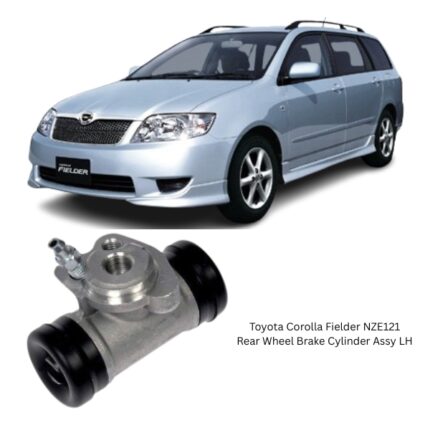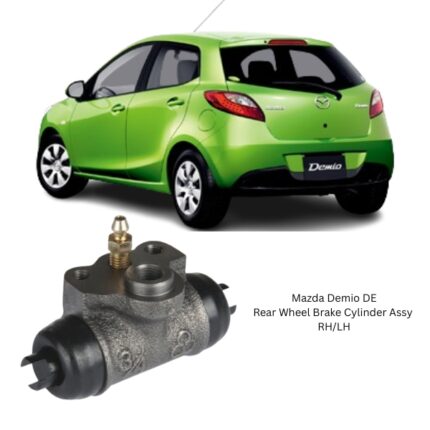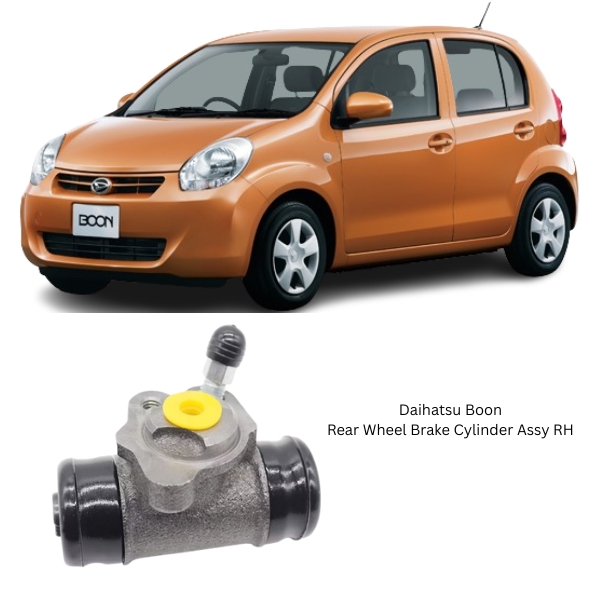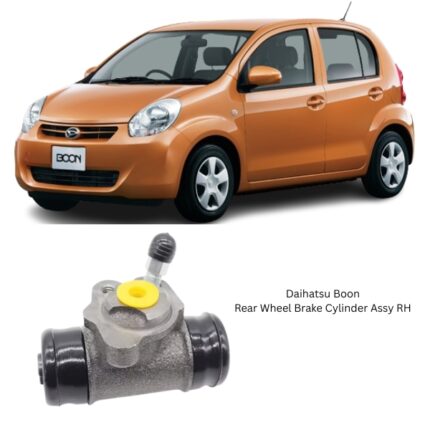-20%
Get Daihatsu Boon Rear Wheel Brake Cylinder Assy RH 47550-52011 in Kenya
The Rear Wheel Brake Cylinder Assembly RH (Right-Hand) is a core hydraulic component of the rear drum brake system. Small in size but powerful in function, it plays a pivotal role in converting hydraulic brake fluid pressure into mechanical force that presses the brake shoes outward against the inner wall of the brake drum. This friction is what slows or stops the vehicle during braking.
Functioning in tandem with the left-side cylinder, the right-hand brake cylinder must deliver consistent and equal performance to maintain proper brake balance and ensure a safe, stable ride. Reliable operation of this part is crucial for uniform brake wear and precise brake modulation across the rear axle.
Purpose and Operation
The primary function of the rear wheel brake cylinder is to act as a hydraulic actuator within the drum brake system. When the driver presses the brake pedal, brake fluid flows under high pressure through the brake lines and into the wheel cylinders located at each rear wheel.
Inside the brake cylinder, the fluid pressure forces two pistons outward in opposite directions. These pistons are in direct contact with the brake shoes. As they move outward, they push the shoes against the spinning brake drum, generating friction to slow down the vehicle. When the pedal is released, springs retract the brake shoes and pistons, allowing the fluid pressure to drop and the cylinder to return to its resting state.
Construction and Materials
Durability and precision are the hallmarks of a properly engineered rear brake cylinder. It is typically constructed from cast iron, aluminum alloy, or zinc-coated steel to ensure strength, corrosion resistance, and thermal endurance. The internal bore is finely machined to allow the pistons to move smoothly under pressure while maintaining a perfect seal to prevent fluid leakage.
Key materials include:
-
Hardened steel or anodized aluminum for the body
-
Rubber or EPDM-based seals and dust boots, capable of withstanding high temperatures and corrosive brake fluid
-
Steel pistons or composite pistons designed to resist wear and corrosion over long-term use
These materials are selected to survive extreme thermal cycling, high hydraulic pressure, and exposure to dirt, moisture, and brake dust—all of which are common in real-world driving conditions.
Key Components
-
Cylinder Body: The structural housing for the pistons and brake fluid. It must retain shape and strength under pressure.
-
Dual Pistons: Two precisely machined pistons, each placed at opposite ends of the cylinder. Their linear movement drives the brake shoes outward.
-
Cup Seals: These rubber seals ensure brake fluid remains pressurized inside the bore while preventing leaks around the pistons.
-
Dust Boots: External boots shield the inner components from contaminants such as moisture, dirt, and grime.
-
Bleeder Valve: A threaded valve used for purging air from the hydraulic brake system during bleeding. Air in the system compromises braking performance.
-
Brake Line Inlet: A port where the hydraulic brake line connects, feeding the cylinder with brake fluid from the master cylinder.
Performance and Characteristics
The effectiveness of the rear drum brake system depends heavily on the responsiveness and sealing integrity of the wheel cylinder. A properly functioning assembly ensures:
-
Consistent brake shoe engagement
-
Balanced rear braking force
-
Even brake wear on both shoes
-
No fluid leaks or contamination inside the drum
The cylinder’s pistons must move without binding or resistance, and its seals must hold pressure without fail. Any loss of pressure due to leakage or internal wear can significantly degrade braking performance and vehicle safety.
Common Issues and Symptoms
Though built to last, the right-hand brake cylinder is still a wear item. Over time, seals can deteriorate, the bore can corrode, and dirt can contaminate internal components. Regular inspection is necessary, especially during brake servicing.
Watch out for:
-
Brake fluid leakage at the wheel or inside the drum
-
Soft or spongy brake pedal feel
-
Brake pull or uneven braking
-
Brake warning light activation
-
Fluid-stained brake shoes
-
Degraded dust boots exposing internals to debris
Any of these signs should prompt immediate inspection and potential replacement to maintain brake system integrity.
Installation Procedure
Replacing a rear brake cylinder involves precision and care. Proper installation ensures that the braking system retains hydraulic integrity and remains free from air or leaks. Below is a simplified overview of the process:
-
Lift the vehicle safely and remove the rear wheel to access the drum brake assembly.
-
Remove the brake drum to expose the brake shoes and wheel cylinder.
-
Disconnect the hydraulic brake line carefully using a flare nut wrench to prevent thread damage.
-
Unbolt the old wheel cylinder from the backing plate.
-
Install the new cylinder in the same position, aligning the mounting holes correctly.
-
Reconnect the brake line, ensuring it is snug but not overtightened.
-
Reassemble the brake shoes, springs, and drum.
-
Bleed the brakes to remove any trapped air and restore proper hydraulic function.
-
Refill brake fluid reservoir and check for leaks or abnormal pedal feel.
-
Test drive cautiously, verifying that the brakes respond smoothly and evenly.
Maintenance Tips
-
Inspect during every brake service: Look for fluid trails, dampness, or rust around the brake cylinder and backing plate.
-
Flush the brake fluid every 1–2 years: Contaminated fluid causes internal corrosion and seal breakdown.
-
Replace shoes if soaked with brake fluid: Contaminated friction material loses its effectiveness and poses safety risks.
-
Check dust boots regularly to ensure they’re intact and seated properly.
Preventive maintenance goes a long way toward extending the life of the brake cylinder and ensuring that the rest of the braking system functions properly.
Contribution to the Braking System
The rear wheel brake cylinder on the right side ensures that braking pressure is evenly distributed across both rear wheels. It works in harmony with its left-side counterpart to deliver balanced force to the drum brake setup. When either side is underperforming due to fluid leakage, piston binding, or seal failure, the entire rear brake performance is compromised.
This component also directly influences:
-
Brake pedal firmness
-
Rear axle stability during braking
-
Longevity of brake shoes
-
Overall safety and braking confidence
Because the brake cylinder is both mechanical and hydraulic in nature, it’s considered one of the more sensitive parts in the braking system. Its performance must be accurate, leak-free, and durable over time.
Follow us on Facebook for more parts.





Reviews
Clear filtersThere are no reviews yet.